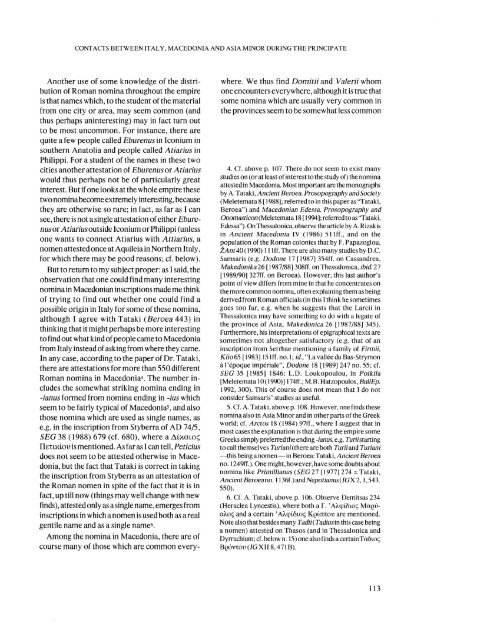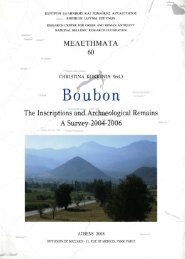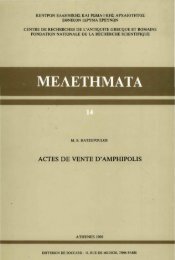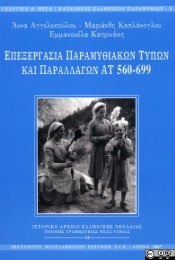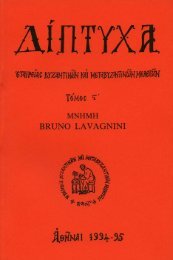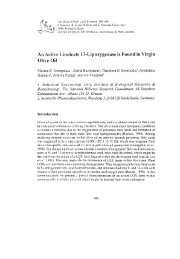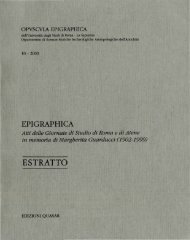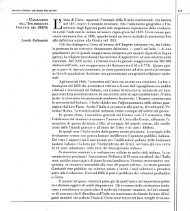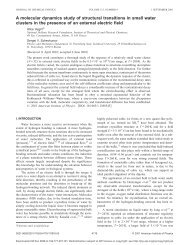Roman onomastics in the Greek East: social and political aspects ...
Roman onomastics in the Greek East: social and political aspects ...
Roman onomastics in the Greek East: social and political aspects ...
You also want an ePaper? Increase the reach of your titles
YUMPU automatically turns print PDFs into web optimized ePapers that Google loves.
CONTACTS BETWEEN ITALY, MACEDONIA AND ASIA MINOR DURING THE PRINCIPATE<br />
Ano<strong>the</strong>r use of some knowledge of <strong>the</strong> distribution<br />
of <strong>Roman</strong> nom<strong>in</strong>a throughout <strong>the</strong> empire<br />
is that names which, to <strong>the</strong> student of <strong>the</strong> material<br />
from one city or area, may seem common (<strong>and</strong><br />
thus perhaps un<strong>in</strong>terest<strong>in</strong>g) may <strong>in</strong> fact turn out<br />
to be most uncommon. For <strong>in</strong>stance, <strong>the</strong>re are<br />
quite a few people called Eburenus <strong>in</strong> Iconium <strong>in</strong><br />
sou<strong>the</strong>rn Anatolia <strong>and</strong> people called Atiarius <strong>in</strong><br />
Philippi. For a student of <strong>the</strong> names <strong>in</strong> <strong>the</strong>se two<br />
cities ano<strong>the</strong>r attestation of Eburenus or Atiarius<br />
would thus perhaps not be of particularly great<br />
<strong>in</strong>terest. But if one looks at <strong>the</strong> whole empire <strong>the</strong>se<br />
two nom<strong>in</strong>abecome extremely <strong>in</strong>terest<strong>in</strong>g, because<br />
<strong>the</strong>y are o<strong>the</strong>rwise so rare; <strong>in</strong> fact, as far as I can<br />
see, <strong>the</strong>re is not a s<strong>in</strong>gle attestation of ei<strong>the</strong>r Eburenus<br />
or Atiarius outside Iconium or Philippi (unless<br />
one wants to connect Atiarius with Attiarius, a<br />
nomen attested once at Aquileia <strong>in</strong> Nor<strong>the</strong>rn Italy,<br />
for which <strong>the</strong>re may be good reasons; cf. below).<br />
But to return to my subject proper: as I said, <strong>the</strong><br />
observation that one could f<strong>in</strong>d many <strong>in</strong>terest<strong>in</strong>g<br />
nom<strong>in</strong>a <strong>in</strong> Macedonian <strong>in</strong>scriptions made me th<strong>in</strong>k<br />
of try<strong>in</strong>g to f<strong>in</strong>d out whe<strong>the</strong>r one could f<strong>in</strong>d a<br />
possible orig<strong>in</strong> <strong>in</strong> Italy for some of <strong>the</strong>se nom<strong>in</strong>a,<br />
although I agree with Tataki (Beroea 443) <strong>in</strong><br />
th<strong>in</strong>k<strong>in</strong>g that it might perhaps be more <strong>in</strong>terest<strong>in</strong>g<br />
to f<strong>in</strong>d out what k<strong>in</strong>d of people came to Macedonia<br />
from Italy <strong>in</strong>stead of ask<strong>in</strong>g from where <strong>the</strong>y came.<br />
In any case, accord<strong>in</strong>g to <strong>the</strong> paper of Dr. Tataki,<br />
<strong>the</strong>re are attestations for more than 550 different<br />
<strong>Roman</strong> nom<strong>in</strong>a <strong>in</strong> Macedonia 4 . The number <strong>in</strong>cludes<br />
<strong>the</strong> somewhat strik<strong>in</strong>g nom<strong>in</strong>a end<strong>in</strong>g <strong>in</strong><br />
-ianus formed from nom<strong>in</strong>a end<strong>in</strong>g <strong>in</strong> -ius which<br />
seem to be fairly typical of Macedonia 5 , <strong>and</strong> also<br />
those nom<strong>in</strong>a which are used as s<strong>in</strong>gle names, as<br />
e.g. <strong>in</strong> <strong>the</strong> <strong>in</strong>scription from Styberra of AD 74/5,<br />
SEG 38 (1988) 679 (cf. 680), where a Δίκαιος<br />
Πετικίου is mentioned. As far as I can tell, Peticius<br />
does not seem to be attested o<strong>the</strong>rwise <strong>in</strong> Macedonia,<br />
but <strong>the</strong> fact that Tataki is correct <strong>in</strong> tak<strong>in</strong>g<br />
<strong>the</strong> <strong>in</strong>scription from Styberra as an attestation of<br />
<strong>the</strong> <strong>Roman</strong> nomen <strong>in</strong> spite of <strong>the</strong> fact that it is <strong>in</strong><br />
fact, up till now (th<strong>in</strong>gs may well change with new<br />
f<strong>in</strong>ds), attested only as a s<strong>in</strong>gle name, emerges from<br />
<strong>in</strong>scriptions <strong>in</strong> which a nomen is used both as a real<br />
gentile name <strong>and</strong> as a s<strong>in</strong>gle name 6 .<br />
Among <strong>the</strong> nom<strong>in</strong>a <strong>in</strong> Macedonia, <strong>the</strong>re are of<br />
course many of those which are common every<br />
where. We thus f<strong>in</strong>d Domitii <strong>and</strong> Valerii whom<br />
one encounters everywhere, although it is true that<br />
some nom<strong>in</strong>a which are usually very common <strong>in</strong><br />
<strong>the</strong> prov<strong>in</strong>ces seem to be somewhat less common<br />
4. Cf. above p. 107. There do not seem to exist many<br />
studies on (or at least of <strong>in</strong>terest to <strong>the</strong> study of) <strong>the</strong> nom<strong>in</strong>a<br />
attested <strong>in</strong> Macedonia. Most important are <strong>the</strong> monographs<br />
by A. Tataki, Ancient Beroea. Prosopography <strong>and</strong> Society<br />
(Meletemata8 [1988]; referred to <strong>in</strong> this paper as "Tataki,<br />
Beroea") <strong>and</strong> Macedonian Edessa. Prosopography <strong>and</strong><br />
Onomasticon (Meletemata 18 [ 1994]; referred to as "Tataki,<br />
Edessa"). On Thessalonica, observe <strong>the</strong> article by A. Rizakis<br />
<strong>in</strong> Ancient Macedonia IV (1986) 51 Iff., <strong>and</strong> on <strong>the</strong><br />
population of <strong>the</strong> <strong>Roman</strong> colonies that by F. Papazoglou,<br />
Z4nf40(1990) 11 Iff. There are also many studies by D.C.<br />
Samsaris (e.g. Dodone 17 [1987] 354ff. on Cass<strong>and</strong>rea,<br />
Makedonika26 [1987/88] 308ff. on Thessalonica, ibid. 27<br />
[1989/90] 327ff. on Beroea). However, this last author's<br />
po<strong>in</strong>t of view differs from m<strong>in</strong>e <strong>in</strong> that he concentrates on<br />
<strong>the</strong> more common nom<strong>in</strong>a, often expla<strong>in</strong><strong>in</strong>g <strong>the</strong>m as be<strong>in</strong>g<br />
derived from <strong>Roman</strong> officials (<strong>in</strong> this I th<strong>in</strong>k he sometimes<br />
goes too far, e.g. when he suggests that <strong>the</strong> Larcii <strong>in</strong><br />
Thessalonica may have someth<strong>in</strong>g to do with a legate of<br />
<strong>the</strong> prov<strong>in</strong>ce of Asia, Makedonica26 [1987/88] 345).<br />
Fur<strong>the</strong>rmore, his <strong>in</strong>terpretations of epigraphical texts are<br />
sometimes not altoge<strong>the</strong>r satisfactory (e.g. that of an<br />
<strong>in</strong>scription from Serrhae mention<strong>in</strong>g a family of Firmii,<br />
Klio65 [1983] 151ff.no.l;ii/.,"LavalléeduBas-Strymon<br />
à l'époque impériale", Dodone 18 [1989] 247 no. 55; cf.<br />
SEG 35 [1985] 1846; L.D. Loukopoulou, <strong>in</strong> Poikila<br />
[Meletemata 10(1990)] 174ff.; M.B. Hatzopoulos, BullEp.<br />
1992, 300). This of course does not mean that I do not<br />
consider Samsaris' studies as useful.<br />
5. Cf. A. Tataki, above p. 108. However, one f<strong>in</strong>ds <strong>the</strong>se<br />
nom<strong>in</strong>a also <strong>in</strong> Asia M<strong>in</strong>or <strong>and</strong> <strong>in</strong> o<strong>the</strong>r parts of <strong>the</strong> <strong>Greek</strong><br />
world; cf. Arctos 18 (1984) 97ff., where I suggest that <strong>in</strong><br />
most cases <strong>the</strong> explanation is that dur<strong>in</strong>g <strong>the</strong> empire some<br />
<strong>Greek</strong>s simply preferred <strong>the</strong> end<strong>in</strong>g -ianus, e.g. Turiistart<strong>in</strong>g<br />
to call <strong>the</strong>mselves Turiam (<strong>the</strong>re are both Turii <strong>and</strong> Turiani<br />
—this be<strong>in</strong>g a nomen—<strong>in</strong> Beroea: Tataki, Ancient Beroea<br />
no. 1249ff.). One might, however, have some doubts about<br />
nom<strong>in</strong>a like Primillianus (SEG 27 [1977] 274 = Tataki,<br />
AncientBeroeano. W36Ï.)anaNepotianus(IGX2,1,543.<br />
550).<br />
6. Cf. A. Tataki, above p. 106. Observe Demitsas 234<br />
(Heraclea Lyncestis), where both a Γ. Άλφίδιος Μαρύαλος<br />
<strong>and</strong> a certa<strong>in</strong> Άλφίδιος Κρίσπου are mentioned.<br />
Note also that besides many Tadii(Tadius<strong>in</strong> this case be<strong>in</strong>g<br />
a nomen) attested on Thasos (<strong>and</strong> <strong>in</strong> Thessalonica <strong>and</strong><br />
Dyrrachium; cf. below n. 15) one also f<strong>in</strong>ds a certa<strong>in</strong> Τάδιος<br />
Βρόντου (/GXII8,47IB).<br />
113


